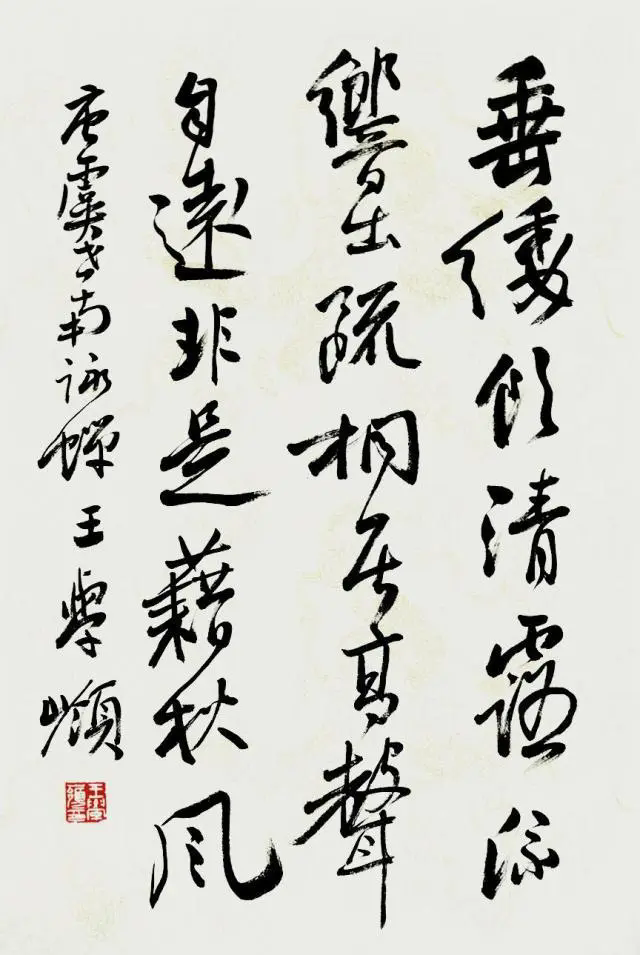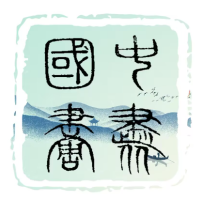王学岭,承中原灵泽,怀墨以探道。少岁习书,若春露润芽,初显锋芒,清劲自成。野风晨露,低回纸上,幽声似入笔端。月下孤灯,影照砚池,手摩古帖,静听千载遗韵,神游艺境。

笔锋轻重若风穿岩谷,流转如泉破石。书非工巧之事,而为意气所存。以恒心炼志,观天地之宏阔,养笔墨之深沉。晨光薄雾间,挥毫如歌,墨韵隐现,万象自生,意远无声。探艺之途,幽而旷达,静而弥坚。王学岭以白卷为契,临古如晤先哲,气象无声而重千钧。其心如凌风之鹰,搏云攀远,苍穹无界,羽声轻却怀远。
王学岭以墨循道,探古铸今,气格自存。楷法之修,起承汉碑雄风,汲北碑苍劲,摄唐楷清峻,尤取《玉版十三行》之隽永流逸,涵欧、褚、虞之雅韵。运锋沉浮,探严整中之灵动,庄穆间寓洒然。其道在“临悟兼行”,揽古迹如对高贤沉思,不拘形影,悟其至微。碑帖相融,方圆并举,劲柔互映,骨格蕴雅而姿致自生,风骨高远不染尘俗。



年岁既深,志守恒一,辄以古典为伴,清灯孤影,心印石刻之奥,笔游残卷之魂。唐碑遗志与《十三行》之妙,循尺摹录,千遍百通。每一临摹,必有新作试炼,以此验思悟所成。于笔端静听,时光如水,古韵沉响,遥遥心契。运墨之间,非徒技之所至,而为心意之栖处,纳天地之思,融薪传之志。
斯行寂而不孤,远而无倦。其临碑如入清涧,水石相激,澄澈灵深。白纸无声,墨迹千钧,似听无弦之音,气象万千而无声自鸣。此艺,非单求工法之完美,乃追美善之真。心志如孤鹤凌霄,振翼穿云,苍穹辽阔,去路漫漫而风声无尽。
王学岭小楷,探古融今,韵致玄远。落笔如访旧迹,步入流光之径。临古之作,如《砖塔铭》《九成宫》《庙堂碑》《十三行》,更以楷法写《兰亭序》。法承古意,神游心悟。观碑帖脉络,如风拂孤松,动静互生。笔势开阖相间,锋收如潜流暗涌,锋起似孤峰初立。墨影轻沉,意象悠回,寄怀无声之叹,幽思无尽。
自创诸篇,虽承碑帖余韵,而气格自铸。横如溪流,静而含光;竖若山径,挺而含韵。藏锋如浪初息,深势未殆;露锋若弦初鸣,清音未绝。纤笔如丝,连绵若脉;沉笔如虹,气贯千里。转折处含柔劲,似泉击石,声息不闻而流势不息。览其墨迹,恍如步入空谷,听万古遗音,心意浮沉,沉吟久远。
王学岭大楷,峻拔如峰,气度沉雄。结体严谨,笔力凝重,若雷霆潜壑,静极生响。疏密间虚实相映,筋骨挺立,遒劲若寒松凌霜,峙立苍茫,锋芒蕴而不显。



行书运锋,若弦拨清音,开阖有致,流转如溪泉绕石,节奏自生。提按沉浮,疾缓相谐,连而不滞,断而不断。墨迹筋脉贯通,气韵悠长,去繁饰而守朴真,于纵横中见沉思,于简洁中现峻志。
章草挥笔,游于静动之间,如云舒高岭,泉落幽壑。连带抑扬,或轻如鸿羽掠波,或重如巨石坠潭。笔势蜿蜒,含蓄生姿,意象高古,气息悠然。观其笔韵,若入松谷听泉,心境清远澄澈。书艺之道,形寓于意,笔随心行,于寂中见远,于静中生动,余韵不绝,深远无尽。
王学岭之书,古今交融,气韵自成。心迹载墨,恒守真诚,探艺之极。行笔如探宇内,寄情于字,筋骨沉毅,气度从容。疏密纵横处,静含万象,动载幽怀,寂中生韵,意出无声。此道深远,守本开新。墨痕无言,而意象恒存,如松风泉韵,悠然不尽,引人入境,悟传承之重,思艺道之久。




Wang Xueling: Pursuing the Path of Ink, Conveying Grand Visions—Forms Unbound, Brush Guided by the Heart.
Wang Xueling, nourished by the spirit of the Central Plains, holds ink as his guide on the path of art. From a young age, he practiced calligraphy with devotion, his early strokes like buds nurtured by spring dew—sharp yet imbued with natural grace. The morning wind and dew seemed to resonate through his paper, their quiet whispers merging into his brushwork. Beneath the moonlit lamp, shadows cast over the inkstone as he traced ancient scripts, listening in silence to echoes from a thousand years past, his mind immersed in the artistic realm.
His brush moves with varied force, like wind threading through mountain ravines or a spring coursing through stone crevices. For him, calligraphy is not mere craftsmanship but a vessel for spirit and intent. With steadfast dedication, he tempers his will and observes the vastness of the world, nurturing the depth of his ink and strokes. In the dawn mist, as the morning light spreads, he wields his brush as if composing a song—ink flows with subtle rhythm, forms emerge, and meaning unfolds without sound.His journey in art is solitary yet boundless, quiet yet unyielding. Wang Xueling treats every blank sheet as a covenant, each transcription like a meeting with the sages of old. The silence of his work bears the weight of great meaning. His heart, like an eagle soaring on the wind, seeks the heights, climbing through clouds to unbounded skies—its wings moving gently, yet carrying the vastness of distant horizons.
Wang Xueling follows the path of ink and brush, seeking the ancient to forge the present, preserving his distinct artistic character. In his mastery of regular script, he inherits the grandeur of Han steles, draws strength from the boldness of Northern inscriptions, and embraces the elegance of Tangics. He particularly admires the fluid grace of the Jade-Plate Thirteen Lines, while absorbing the refined essence of Ouyang, Chu, and Yu's styles. His strokes rise and fall, balancing precision with vitality, solemnity with an unrestrained spirit. His approach follows the principle of "practice with insight," contemplating ancient masterpieces as dialogues with sages, transcending form to grasp their essence. The fusion of stele and manuscript yields a harmony of strength and softness, compositional integrity enriched by a natural elegance—lofty in spirit, untouched by the mundane.
As years passed, his dedication remained unwavering. Ancient texts became his constant companions, with solitary lamplight illuminating his quiet study. His heart attuned to the soul of stone inscriptions, his brush danced with the spirit of ancient scrolls. He devoted years to the study of Tang inscriptions and the Thirteen Lines, meticulously reproducing their full dimensions through countless renditions. Each transcription was followed by a new creation to test his comprehension and deepen his understanding. His brush seemed to listen to the flow of time, as ancient melodies resonated through his ink, forming a distant but profound connection. For him, mastery lies not merely in technique but in creating a resting place for the spirit—imbued with reflections on the universe and a commitment to passing down tradition.
This journey, though solitary, is never desolate; though long, it is free from weariness. His study of inscriptions resembles entering a clear stream, where water and stone meet and echo in purity. The blank scroll holds no sound, yet the ink bears a thousandfold weight, like the silent reverberation of a stringless melody, resonating with immense depth. This art pursues not perfection in craft alone, but the essence of beauty and virtue. His resolve is like a lone crane soaring in the heavens, its wings cutting through the clouds. The vast sky stretches endlessly before him, and though the path is boundless, the sound of his flight remains eternal.
Wang Xueling's small-script calligraphy bridges the ancient and the modern, exuding a profound and distant charm. His strokes unfold like a journey through time, as if revisiting traces of the past. In his works such as Inscription on the Brick Pagoda, Jiu Cheng Palace, Stele of the Temple Pavilion, and The Thirteen Lines, he even recreates The Lanting Preface in regular script. Though grounded in ancient principles, his artistry emerges from personal reflection. The rhythm of his brushwork resembles the wind brushing through lone pines, where movement and stillness intertwine. His strokes alternate between expansion and restraint—restrained like an undertow and forceful like a solitary peak. Ink shifts between light and dark, forming an ethereal resonance, carrying an unspoken lament, endless in its quiet contemplation.
In his original compositions such as The Peach Blossom Spring, The Pavilion of Prince Teng, The Jia Shen Cultural Manifesto, The Old Drunkard's Pavilion, The Sound of Autumn, and Maxims for Family Governance, traces ofical influence remain, yet his unique spirit shines through. Horizontal strokes flow like serene streams, calm yet gleaming; vertical strokes rise like mountain paths, upright yet resonant. Hidden edges hold the depth of a receding wave; exposed tips resonate like the first note of a plucked string. Fine lines are like silk threads, continuous and alive; bold strokes resemble rainbows, spanning vast distances. His brushwork's turns embody supple strength, like springs striking stone—silent yet ceaseless in flow. Observing his ink traces is akin to stepping into a secluded valley and hearing echoes of ancient melodies, where thoughts rise and fall, lingering in timeless reverie.
Wang Xueling’s large script stands lofty as a peak, exuding majestic power. The structure is precise, the strokes resolute, like thunder rumbling in a hidden valley, resonating after profound stillness. Between density and openness, contrasts of void and fullness interplay. The framework remains upright, as resilient as frost-laden pines rooted against vast horizons, with latent strength that does not boast.
His running script flows with the grace of plucked strings, its rhythm unfolding in measured harmony. The lines twist and glide like a stream encircling stones, where the motion defines its own cadence. Press and lift alternate with depth and poise, swift yet steady, unbroken yet varied. The ink traces carry sinew and pulse, with an enduring breath of vitality. Forsaking ornamental excess, he pursues simplicity and authenticity, weaving contemplation into every stroke, revealing resolute spirit within refined forms.
In his cursive script, the brushwork drifts between movement and stillness, like clouds unfurling across ridges or springs cascading through deep ravines. The connections rise and fall—light as feathers brushing the surface of water, weighty as boulders plunging into a pool. His strokes coil with restrained elegance, evoking images of timeless antiquity and a serene breath of distant calm. Observing his brushstrokes feels like entering a pine-clad valley, listening to the murmur of flowing streams, and finding one’s heart cleansed and tranquil. In this art, form embodies intention, the brush follows the heart, and within silence emerges distance, within stillness unfolds motion. Its resonance lingers endlessly, reverberating into boundless depths.
Wang Xueling’s calligraphy bridges the ancient and the modern, exuding a distinct rhythm and charm. His ink traces reflect sincerity and unwavering dedication, striving for the highest realm of artistry. Each stroke moves as though exploring the vast universe, emotions embedded within each character. The lines hold steadfast strength and composed elegance. In the interplay of density and openness, stillness embraces myriad reflections, while motion conveys profound emotions. From silence, resonance arises, conveying meaning without sound.His path extends far, rooted in tradition yet open to innovation. The ink leaves no voice, yet the imagery endures—like the whisper of pine winds and the murmur of flowing streams, endlessly resonant. It invites one to enter its world, to perceive the weight of heritage and contemplate the enduring journey of artistic pursuit.
责任编辑:苗君
